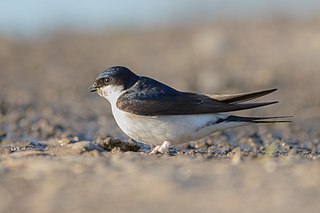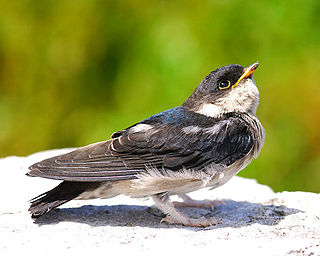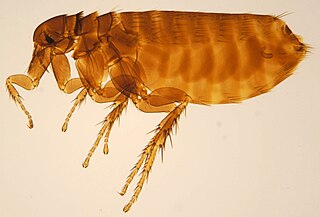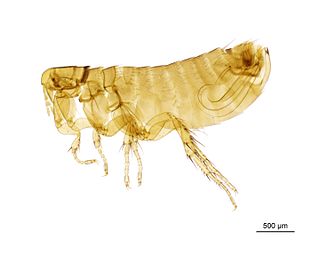
The common house martin, sometimes called the northern house martin or, particularly in Europe, just house martin, is a migratory passerine bird of the swallow family which breeds in Europe, north Africa and across the Palearctic; and winters in sub-Saharan Africa and tropical Asia. It feeds on insects which are caught in flight, and it migrates to climates where flying insects are plentiful. It has a blue head and upperparts, white rump and pure white underparts, and is found in both open country and near human habitation. It is similar in appearance to the two other martin species of the genus Delichon, which are both endemic to eastern and southern Asia. It has two accepted subspecies.

Delichon is a small genus of passerine birds that belongs to the swallow family and contains four species named as house martins. These are chunky, bull-headed and short-tailed birds, blackish-blue above with a contrasting white rump, and with white or grey underparts. They have feathering on the toes and tarsi that is characteristic of this genus. The house martins are closely related to other swallows that build mud nests, particularly the Hirundo barn swallows. They breed only in Europe, Asia and the mountains of North Africa. Two species, the common and Asian house martins, migrate south in winter, while the Nepal house martin is resident in the Himalayas year-round.

The Asian house martin is a migratory passerine bird of the swallow family Hirundinidae. It has mainly blue-black upperparts, other than its white rump, and has pale grey underparts. Its three subspecies breed in the Himalayas and in central and eastern Asia, and spend the winter lower in the mountains or in Southeast Asia. This species is locally abundant and is expanding northward in Siberia, so there are no concerns about its conservation status.

Bulbophyllum hirundinis is a species of orchid in the genus Bulbophyllum.

Isopogon ceratophyllus, commonly known as the horny cone-bush or wild Irishman, is a plant of the family Proteaceae that is endemic to the coast in Victoria, South Australia and on the Furneaux Group of islands in Tasmania. It is a small woody shrub that grows to 100 cm high with prickly foliage. It is extremely sensitive to dieback from the pathogen Phytophthora cinnamomi

Ceratophyllus gallinae, known as the hen flea in Europe or the European chicken flea elsewhere, is an ectoparasite of birds. This flea was first described by the German botanist and entomologist Franz von Paula Schrank in 1803.

Ceratophyllus is a widespread genus of fleas found in temperate climates. Some of its members include the chicken flea, Ceratophyllus gallinae, and the poultry flea, Ceratophyllus niger.
Ceratophyllus adustus is a species of flea in the family Ceratophyllidae. It was described by Karl Jordan in 1932.
Ceratophyllus affinis is a species of flea in the family Ceratophyllidae. It was described by Nordberg in 1935.
Ceratophyllus altus is a species of flea in the family Ceratophyllidae. It was described by Tipton and Mendez in 1966.
Ceratophyllus niger, also known as the western chicken flea or the black hen flea, is an ectoparasite of birds. It is a member of the family Ceratophyllidae and was described by Fox in 1908.
Ceratophyllus breviprojectus is a species of flea in the family Ceratophyllidae. It was described by Liu, Wu and Wu in 1966.
Ceratophyllus calderwoodi is a species of flea in the family Ceratophyllidae. It was described by George P. Holland in 1979.

Ceratophyllus columbae is a species of flea in the family Ceratophyllidae. It was described by Gervais in 1844.
Ceratophyllus ciliatus is a species of flea in the family Ceratophyllidae. It was described by Baker in 1904.
Ceratophyllus phrillinae is a species of flea in the family Ceratophyllidae. It was described by Smit in 1976.

Ceratophyllus garei, the duck flea, is a species of flea in the family Ceratophyllidae. It was described by Rothschild in 1902.
Ceratophyllus frigoris is a species of flea in the family Ceratophyllidae. It was described by Darskaya in 1950.
Ceratophyllus gilvus is a species of flea in the family Ceratophyllidae. It was described by Karl Jordan and Charles Rothschild in 1922.
Ceratophyllus qinghaiensis is a species of flea in the family Ceratophyllidae. It was described by Guangdeng and Liming in 1985.








